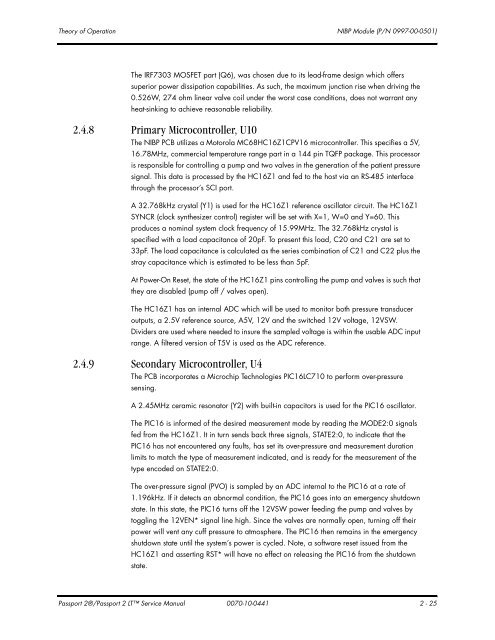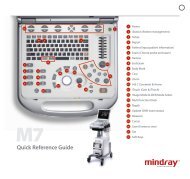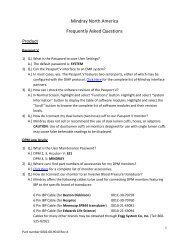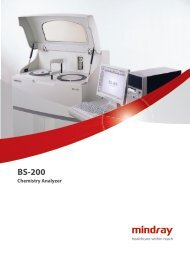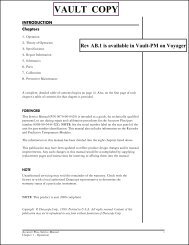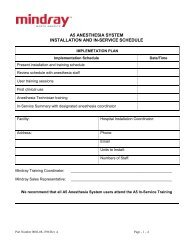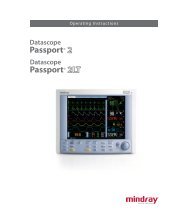Datascope Passport - Mindray
Datascope Passport - Mindray
Datascope Passport - Mindray
You also want an ePaper? Increase the reach of your titles
YUMPU automatically turns print PDFs into web optimized ePapers that Google loves.
Theory of Operation NIBP Module (P/N 0997-00-0501)<br />
The IRF7303 MOSFET part (Q6), was chosen due to its lead-frame design which offers<br />
superior power dissipation capabilities. As such, the maximum junction rise when driving the<br />
0.526W, 274 ohm linear valve coil under the worst case conditions, does not warrant any<br />
heat-sinking to achieve reasonable reliability.<br />
2.4.8 Primary Microcontroller, U10<br />
The NIBP PCB utilizes a Motorola MC68HC16Z1CPV16 microcontroller. This specifies a 5V,<br />
16.78MHz, commercial temperature range part in a 144 pin TQFP package. This processor<br />
is responsible for controlling a pump and two valves in the generation of the patient pressure<br />
signal. This data is processed by the HC16Z1 and fed to the host via an RS-485 interface<br />
through the processor’s SCI port.<br />
A 32.768kHz crystal (Y1) is used for the HC16Z1 reference oscillator circuit. The HC16Z1<br />
SYNCR (clock synthesizer control) register will be set with X=1, W=0 and Y=60. This<br />
produces a nominal system clock frequency of 15.99MHz. The 32.768kHz crystal is<br />
specified with a load capacitance of 20pF. To present this load, C20 and C21 are set to<br />
33pF. The load capacitance is calculated as the series combination of C21 and C22 plus the<br />
stray capacitance which is estimated to be less than 5pF.<br />
At Power-On Reset, the state of the HC16Z1 pins controlling the pump and valves is such that<br />
they are disabled (pump off / valves open).<br />
The HC16Z1 has an internal ADC which will be used to monitor both pressure transducer<br />
outputs, a 2.5V reference source, A5V, 12V and the switched 12V voltage, 12VSW.<br />
Dividers are used where needed to insure the sampled voltage is within the usable ADC input<br />
range. A filtered version of T5V is used as the ADC reference.<br />
2.4.9 Secondary Microcontroller, U4<br />
The PCB incorporates a Microchip Technologies PIC16LC710 to perform over-pressure<br />
sensing.<br />
A 2.45MHz ceramic resonator (Y2) with built-in capacitors is used for the PIC16 oscillator.<br />
The PIC16 is informed of the desired measurement mode by reading the MODE2:0 signals<br />
fed from the HC16Z1. It in turn sends back three signals, STATE2:0, to indicate that the<br />
PIC16 has not encountered any faults, has set its over-pressure and measurement duration<br />
limits to match the type of measurement indicated, and is ready for the measurement of the<br />
type encoded on STATE2:0.<br />
The over-pressure signal (PVO) is sampled by an ADC internal to the PIC16 at a rate of<br />
1.196kHz. If it detects an abnormal condition, the PIC16 goes into an emergency shutdown<br />
state. In this state, the PIC16 turns off the 12VSW power feeding the pump and valves by<br />
toggling the 12VEN* signal line high. Since the valves are normally open, turning off their<br />
power will vent any cuff pressure to atmosphere. The PIC16 then remains in the emergency<br />
shutdown state until the system’s power is cycled. Note, a software reset issued from the<br />
HC16Z1 and asserting RST* will have no effect on releasing the PIC16 from the shutdown<br />
state.<br />
<strong>Passport</strong> 2®/<strong>Passport</strong> 2 LT Service Manual 0070-10-0441 2 - 25


